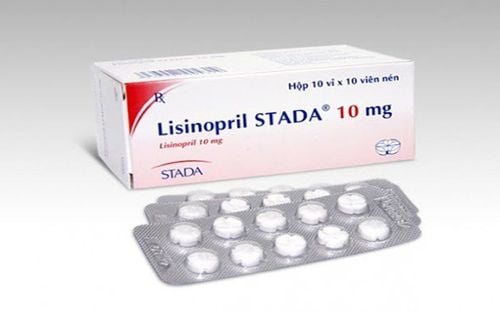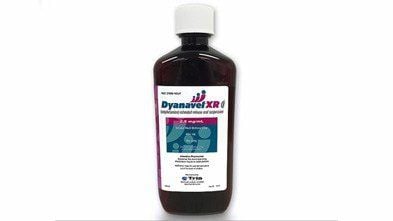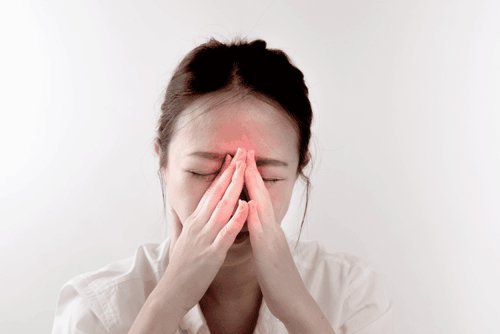This is an automatically translated article.
Forehead headache is a common condition and can potentially have many dangerous medical conditions. So what is the cause or cause of this forehead headache? How and when to see a doctor? All of the above questions will be answered through the article below.
1. What is a frontal headache?
Headaches or headaches come in all shapes and sizes, with frontal or frontal headaches being some of the most common. The pain is usually felt just above the forehead and is often referred to as a frontal headache. Patients often feel like something is pressing on both sides of the head, pain intensity is mild to moderate. Some people describe it as like a headband or belt that tightens around your head. Sometimes the pain can be more severe. The area of pain can be isolated to one point or spread to the entire forehead. It can also spread down the entire face, causing complete weakness until the headache goes away.
Frontal headaches can be related to another type of headache known as temporal headaches, which affect the sides of the skull. While this is usually short-lived, it can recur over and over again. Frontal headaches can last for days or weeks, but this is not very common.
Headaches can have many causes, so it's important to evaluate frontal headaches along with other symptoms. Although most frontal headaches aren't serious, the intensity of the pain can tell you what's causing the pain.
Symptoms of a frontal headache:
A frontal headache will often be accompanied by additional signs and symptoms of the underlying condition. For example, if a patient has a sinus infection, other nasal symptoms are also common. It is important to remember that headaches are not a disease, but a symptom. The following are some of the most common associated symptoms that accompany a headache:
Red, burning and watery eyes Blurred or double vision Nasal congestion Runny nose and sneezing Nasal voice to voice Facial pain, nose pain, cheek pain, jaw pain Nausea and sometimes vomiting Dizziness

Đau đầu vùng trán là tình trạng thường gặp ở một số người
2. Causes or causes of headaches in the forehead area
Forehead headaches have many causes and to determine exactly what is causing the pain, besides going to medical facilities, performing paraclinical tests such as MRI or CT - scanner , which will help determine the brain structure and rule out possible causes, you also need to know the following:
When your frontal headache starts How long does the pain last You have the pain how the pain is located How severe is the pain How do you feel you have suffered and are suffering whether specific activities or environmental conditions affect the pain Did you notice any trigger and here are the causes of frontal headache :
2.1. Eye strain Constantly looking at bright lights or overusing your eyes is a common problem that leads to eye strain, which can lead to a forehead or forehead headache. Most people stare at a computer screen for long periods of time at work and by the time they get home, they're staring at a phone or television screen. This adds to the eyeball's exposure time to electronic devices causing your eyes to strain and headaches are inevitable.
2.2. Sinus The sinus cavity is located in the anterior part of the skull. It consists of large air-filled voids located behind the nose in the middle of the face. When this area becomes infected or congested, it can lead to a burning sensation and develop a headache.
2.3. Muscle tension is the cause of acute headaches that come on suddenly. Muscle spasms or tension in the frontal muscles can cause pain that can radiate outward, leading to a headache. Tension headaches are also known as tension headaches and present as a band-like pain in the forehead. The pain may be worse during the day and ease after rest. Muscle tension can be caused by stress, fatigue, poor posture or even dehydration.
2.4. Migraine A medical condition characterized by frequent headaches, with frontal headaches being a possible manifestation. There are a number of reasons why a person might experience migraines, such as changes in hormone levels in the brain or other environmental factors. Migraine-related frontal headaches may be accompanied by other symptoms such as blurred vision, nausea, vomiting, or dizziness.
2.5. Inflammation Swelling and inflammation can increase pressure around your forehead and temples. This can be caused by illness or by an increased amount of fluid in the soft tissues of the head and neck.
2.6. Meningitis More serious infections, such as meningitis, can also cause forehead pain. This infection occurs in the sac of fluid that surrounds your brain and spinal cord. This infection is a serious condition and requires immediate medical attention.
2.7. Giant cell arteritis Giant cell arteritis or GCA is an inflammatory disease of the large and medium blood vessels. Giant cell arteritis Giant cell arteritis primarily affects the great arteries of the neck specifically the branches of the external carotid artery. The inflammation leads to impaired blood flow, causing various symptoms such as frontal headaches, altered vision, and jaw pain when chewing.
Giant cell arteritis usually occurs in the temples, both sides, or just one. Sometimes it can also cluster in the forehead area or even spread to the back of the head. Many people will feel a lot of pain when combing their hair or wearing a hat.
There are various symptoms that suggest a diagnosis of GCA giant cell arteritis. You may have a fever or feel achy all over, fatigue, and significant weight loss. This headache can happen continuously for a long time for several weeks, even months. Vision changes, such as complete loss of vision in one eye or double vision, can occur with giant cell arteritis.
2.8. Brain Tumor A brain tumor occurs when cells in the brain grow out of control and in an abnormal way. There are different types of brain tumours, and they grow at different rates, some slowly and some very quickly. Brain tumors are usually divided into benign and malignant, with brain tumors having a worse prognosis. Usually, a brain tumor headache is dull and constant, or it can be a sharp pain. On the other hand, some brain tumors do not cause any pain.

U não là một trong các nguyên nhân gây đau đầu vùng trán và hốc mắt
Forehead or brain tumor headaches are often worse at night and people often report that the pain keeps them awake. Headaches that frequently occur or get worse on the same side as the tumor. But the headache can also be generalized, especially if it is caused by increased intracranial pressure (ICP) or hydrocephalus (obstruction of the ventricular system in the brain).
There may be other symptoms associated related to brain tumors other than headache. These include:
Convulsions Nausea and vomiting Loss of consciousness Memory loss or other cognitive changes Mood disorders (depression) or personality changes Muscle weakness Difficulty with language (ie slurred speech) ) Vision problems 2.9. Using a lot of stimulants Hanging up can cause headaches in particular or headaches in general, and even drug withdrawal can cause these pains. Quitting caffeine, alcohol, or other substances can trigger a number of symptoms, including forehead pain.
2.10. Vestibular disorders This disease is common in many people, especially women. Typical symptoms include: pain in many areas of the forehead, feeling that the arteries on both sides of the temple are beating faster than usual, dizziness, dizziness, nausea or vomiting when changing positions.
2.11. Cerebral circulatory insufficiency A simple understanding of cerebral circulatory insufficiency is a condition in which the brain is not supplied with enough oxygen to nourish cells, thereby leading to symptoms such as headache, especially in the forehead area, difficulty sleeping, loss of sleep. sleep, forgetfulness, and difficulty concentrating.
2.12. Psychological headaches These are headaches caused by overstimulated nerves that lead to the brain being unable to handle stress. Not only headaches in the forehead, patients with psychological headaches also have other symptoms such as anxiety, impaired memory, poor concentration, even depression. These headaches are often persistent and can intensify when you are emotional.

Đau đầu vùng trán có thể do tình tâm lý gây ra
3. What can you do to prevent frontal headaches?
Treatment of forehead pain is based on understanding the cause of forehead pain in the first place.
Common prevention techniques may include:
Practice relaxation. Tension and stress headaches may be less frequent with relaxation options like deep breathing, yoga, and massage. Eat and drink regularly. Low blood sugar and headaches when hungry will not be a problem if you maintain a regular eating habit with nutritious meals. Offers a full range of food groups. Foods rich in antioxidants
Avocados, oranges, tangerines, honey, salmon,... are foods rich in antioxidants, which help protect blood vessels as well as enhance brain function effectively.
Iron-rich foods
In the process of producing red blood cells, iron is an important and indispensable trace element. If headaches are caused by cerebrovascular diseases, supplementing with this group of foods will significantly reduce headache symptoms. Food groups rich in iron are beef, animal liver, nuts,...
Foods rich in omega -3 fatty acids
Omega 3 is an unsaturated fat, which helps protect blood vessels, brain and system joints of the body. Foods rich in omega 3 are fish (salmon, mackerel, herring,...), dark green vegetables, flaxseed,...
Avoid certain activities. If your headache gets worse when you're playing video games, sitting in the backseat, or reading in low light, avoid these as best you can. Monitor your blood pressure. High blood pressure headaches can be quite painful. Keeping your blood pressure low will help your head and heart. Apply some pain relief tips such as: Massage temples - press sugar; Apply a warm towel to the forehead to help increase blood circulation; Drink ginger tea, chrysanthemum tea; Steam the nose with herbs such as lemongrass, mint, perilla; Clean the nose area with warm salt water. If the above methods do not improve your condition, visit a medical facility, your doctor will examine you and determine the most useful treatment for you. Vinmec International General Hospital is one of the hospitals that not only ensures professional quality with a team of leading doctors, modern equipment and technology, but also stands out for its examination and consulting services. and comprehensive, professional medical treatment; civilized, polite, safe and sterile medical examination and treatment space.
Please dial HOTLINE for more information or register for an appointment HERE. Download MyVinmec app to make appointments faster and to manage your bookings easily.













